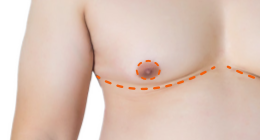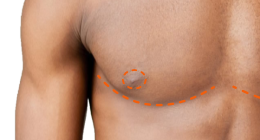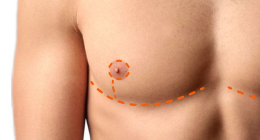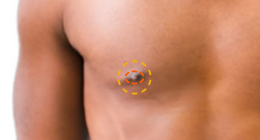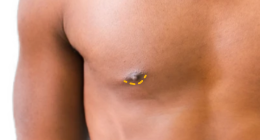Sponsored Article
Top Surgery and Sensation
Concerned about loss of sensation after Top Surgery, or just wondering about how your new chest will feel?
Retaining sensation is very important to many trans men considering Top Surgery but little has been written on the subject. Academic studies on Top Surgery are primarily focused on visual results and complication rates, leaving the topic of sensation to the realm of anecdotal reports on the Internet. Learn more about sensation, breast anatomy and what kind of sensation to expect after Top Surgery in this first-of-its-kind primer featuring expert commentary by Dr. Scott Mosser.
First, it's important to define the different types of sensation:
- Tactile sensation - Also called touch sensation, this is the
sensation produced by pressure receptors in the skin.
- Temperature sensation - Also called thermosensation, this is
the sensation of warm and cold.
- Pain sensation - The sensation of acute discomfort.
- Erogenous sensation - This is the type of sensation that generates sexual response.
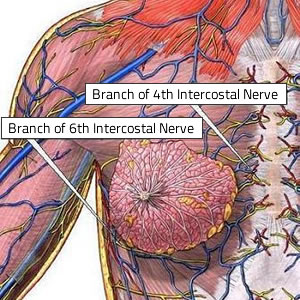 To understand how
Top Surgery impacts sensation, it's also important to
know a bit about breast anatomy. Breast tissue has a rich network
of sensory nerves, supplied mainly by branches of the 4th through
6th intercostal
nerves. While there is some variation person-to-person with
regards to the exact path of the nerves, they generally pass
through the fascia covering the pectoral muscles to reach the
surface of the skin.
To understand how
Top Surgery impacts sensation, it's also important to
know a bit about breast anatomy. Breast tissue has a rich network
of sensory nerves, supplied mainly by branches of the 4th through
6th intercostal
nerves. While there is some variation person-to-person with
regards to the exact path of the nerves, they generally pass
through the fascia covering the pectoral muscles to reach the
surface of the skin.
All Top Surgery procedures all have one common characteristic: the removal of breast tissue underneath the nipple. This can affect blood flow to the nerves, resulting in some loss of sensation. The amount and type of sensation that can be lost is partly dependent on the type of Top Surgery procedure performed.
Choosing a Top Surgery Procedure That Retains Sensation
The most common type of Top Surgery is the Double Incision (DI) method. With this surgery, the nipple-areolar complex (NAC) is completely removed and grafted on in a higher position on the chest. This severs the nerves that go into the nipple-areola, and as they are not microsurgically reconnected there is a substantial likelihood for loss of sensation in the nipples and areola.
Despite this, many trans men who have had Double Incision report very good sensation, including erogenous sensation. In a German study published in 2014, nipple sensitivity was rated as "very good" or "good" in 80.3% of the breasts. (Double Incision with free nipple grafting was performed in 62 breasts or 17.9%.)
While it's encouraging to know that retaining very good nipple sensation is possible with DI, it's unclear if the sensation that's reported is in the nipple or actually under it. Dr. Scott Mosser, a board-certified Surgeon who specializes in Top Surgery, shared his perspective:
I do a partial skin removal, not complete, for skin graft recipient sites. Therefore some of the deep skin sensation end units (pacinian corpuscles) will still be there beneath the graft, as will other mechanoreceptors.
It is not well known how many of the mechanoreceptors which come along with the graft actually help with sensation. When a surgeon removes the entire layer of skin (leaving only fat beneath) the sensation would presumably be much poorer.
I tell patients that with my technique they should lightly scratch their upper chest with their fingernail before surgery – that is the sensation level the nipples will have in 90% of patients after surgery.
 Dr.
Scott W. Mosser, MD, FACS is a board certified
(American Board of Plastic Surgeons), award-winning plastic
surgeon who is an expert at performing several types of FTM/N
Top Surgery. Dr. Mosser
is a member of WPATH and accepts insurance for Top Surgery from
a growing list of insurance companies. Based in San Francisco,
Dr. Mosser sees patients from around the country.
Dr.
Scott W. Mosser, MD, FACS is a board certified
(American Board of Plastic Surgeons), award-winning plastic
surgeon who is an expert at performing several types of FTM/N
Top Surgery. Dr. Mosser
is a member of WPATH and accepts insurance for Top Surgery from
a growing list of insurance companies. Based in San Francisco,
Dr. Mosser sees patients from around the country.
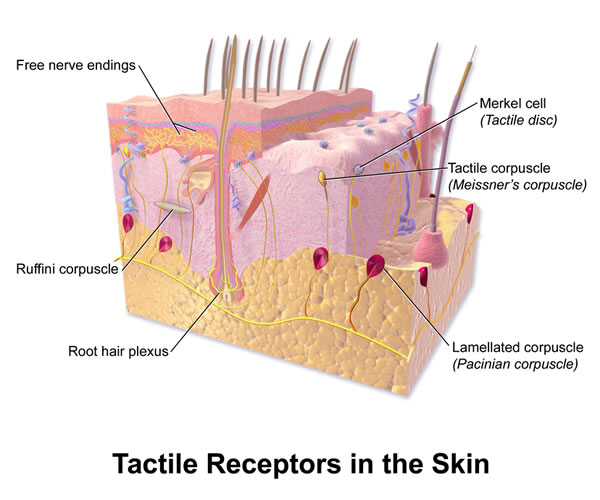
Credit: Blausen.com staff. "Blausen gallery 2014". Wikiversity Journal of Medicine. DOI:10.15347/wjm/2014.010. ISSN 20018762.
Keyhole and Peri-areolar Top Surgery methods do not involve removal of the NAC. Instead, the natal nipple stalk is preserved, offering a better chance at preserving sensation in the nipple and areola. However, these procedures are only suited to smaller chested trans men with good skin elasticity.
Another procedure that was designed to preserve sensation is Inverted-T. Like Keyhole and Peri-areolar, the Inverted-T (or T-anchor) method keeps the nipple attached to its blood and nerve supply, thereby preserving a degree of sensation that isn't possible with nipple grafts. Unlike Keyhole and Peri-Areolar, Inverted-T is suited to medium and large chested men.
What Kind of Sensation to Expect After Top Surgery
In the days following surgery, it's common to feel quite a bit of numbness in the chest. This may be widespread or limited to some smaller "dead spots."
During the first month or two post-op, many trans men experience prickly, stinging or burning sensations. This is a normal sign of healing. During Top Surgery, nerves can be compressed or stretched, and post-operative swelling can further impact the nerves. The "pins & needles" sensations are signs that the nerves are healing.
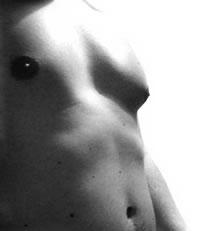 Itchiness is another common sensation
after Top Surgery. Often, this is caused by the natural reduction
of swelling or from irritation caused by a compression garment.
While the itchy feeling can be annoying, it can be easily treated
with an unscented moisturizing cream. (Be careful not to apply any
topical creams to incisions until they have completely closed.)
Sometimes itchiness is the result of hypersensitivity or allergic
reaction to tape and/or steri-strips. An anti-histamine like
Benadryl or topical steroids can be used to treat this. Itchiness
accompanied by swelling and/or redness can be an indication of
infection and should be reported to your Surgeon for assessment.
Itchiness is another common sensation
after Top Surgery. Often, this is caused by the natural reduction
of swelling or from irritation caused by a compression garment.
While the itchy feeling can be annoying, it can be easily treated
with an unscented moisturizing cream. (Be careful not to apply any
topical creams to incisions until they have completely closed.)
Sometimes itchiness is the result of hypersensitivity or allergic
reaction to tape and/or steri-strips. An anti-histamine like
Benadryl or topical steroids can be used to treat this. Itchiness
accompanied by swelling and/or redness can be an indication of
infection and should be reported to your Surgeon for assessment.
In general, it can take anywhere from 6-12 months to regain sensation.
While it's uncommon to lose all sensation after Top Surgery, some
trans men who have had DI Top Surgery report total loss of
erogenous sensation. Patients who are
at higher risk of nipple graft failure and thus loss of
sensation are smokers and those diagnosed with diabetes or an
autoimmune disease.
Despite the potential for loss of sensation, trans men generally report high levels of satisfaction with Top Surgery. If retaining sensation is high on your list of needs, speak with an experienced Surgeon about your best options.
Check out the Ultimate Primer on Top Surgery and Nipples to learn more about:
- Free Nipple Grafts Explained
- Nipple and Areola Size
- Areola Shape
- NAC Positioning
- Nipple Sensation
- Healing of the NAC
- NAC Pigmentation
- Opting Out of Nipples
Last updated: 09/19/23
